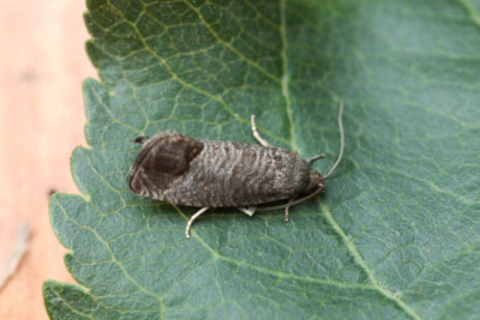Quick facts
- Codling moth (Cydia pomonella) feeds inside apples, which makes the fruit unsuitable for eating.
- It is common in southeastern and central Minnesota, particularly in places where commercial orchards are nearby.
- If codling moth is common in your area, it is very important to manage this pest.
- Keeping your orchard or garden clean will reduce the chance of attack from pests.
How to identify codling moths
- Adults are medium-sized (about 3/8 inch long) and light grayish brown.
- The males have a distinctive band of shiny coppery scales at the end of the wings.
- The codling moth larva is large (up to ½ inch long), and has a pinkish body with a brownish head.
Life cycle of codling moths
There are two generations of codling moth in Minnesota.
- First generation adults emerge from their overwintering sites in spring, just before bloom.
- Mated female moths lay up to 100 eggs on small, developing apples.
- The hatched larvae feed at the surface of the fruits and eventually chew an opening in the apple skin.
- Mature larvae exit the fruit, drop to the ground and crawl away to sheltered places to spin cocoons.
- Some larvae remain in cocoons through winter, and emerge as adults in the spring.
- Other larvae transform to pupae immediately, and emerge as adult moths 2-3 weeks later, flying to the tree canopy to mate.
- A second generation that can start in late July or early August overwinters as mature larvae in cocoons. This second flight is not important in home apple orchards.
Damage caused by codling moths
The larvae tunnel towards the apple cores and feed on the seeds before exiting the fruit.
Crumbly golden-brown frass (excrement) is sometimes found at the hole where the larva exited the apple.
How to protect your garden from codling moths
If you have never had a codling moth problem in your orchard, then you would probably have low numbers of this pest.
Keep your garden or orchard clean
- Pick up and remove any fallen apples throughout the growing season and after harvest and place them in the trash.
- Do not throw away apples in places where you also store apples.
- Inspect your crates and the storage building for cocoons and destroy the insects.
- Harvested apples may contain codling moth larvae, that might exit the fruit and seek shelter in the storage area.
- Storage structures like a garage or barn may be a source of codling moths the next spring.
- Wooden apple crates provide shelter for the larvae in winter.
Codling moth adults can fly as far as a mile to find mating sites on apple trees. If you live in an area where codling moths are common, maintaining cleanliness will not be enough.
Trapping codling moths
Codling moths are trapped using a tent-shaped plastic or waxed-paper trap, hung in a tree. The most common are "delta” traps or "wing” traps.
On the inside, the trap is coated with tanglefoot (made up of a natural, sticky substance). A lure that gives off artificial female pheromones is used as bait. Male moths seeking a mate fly into the trap and get stuck in the tanglefoot.
- In early May, hang the trap at about eye level on the outside of the tree canopy.
- Check the trap weekly starting in mid-May, to see if you have codling moths in your area.
- Clean out the moths and any other insects each time you check the trap.
- If you don’t catch any codling moth adults, you might not require pesticide sprays to control them.
- Lures are effective only for one or two months.
Always use a pair of tweezers used only for handling codling moth lures, or use disposable gloves. Otherwise, you may transfer attractant pheromone to surfaces other than the trap.
See Pest management for the home apple orchard, for information about where to buy trapping materials.
Using pesticides
If you trap codling moths, treat your apples soon after the first flight has begun.
- The best time to spray is when most or all of the petals have fallen from the apple blossoms.
- Do not treat before this as the sprays will be ineffective and will also kill pollinating bees.
- Make a second spray, 7 to 10 days later.
Chemicals that control codling moth include spinosyn, carbaryl, esfenvalerate and malathion.
If you want to control codling moth and apple scab at the same time:
- Mix pesticide and fungicide in the same tank, or
- Use a pre-mixed all-purpose fruit spray that does not contain carbaryl.
CAUTION: Mention of a pesticide or use of a pesticide label is for educational purposes only. Always follow the pesticide label directions attached to the pesticide container you are using. Remember, the label is the law.
Be sure that the fruit/vegetable you wish to treat is listed on the label of the pesticide you intend to use. Also be sure to observe the number of days between pesticide application and when you can harvest your crop.
Reviewed in 2019






